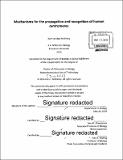| dc.contributor.advisor | lain M. Cheeseman. | en_US |
| dc.contributor.author | McKinley, Kara Lavidge | en_US |
| dc.contributor.other | Massachusetts Institute of Technology. Department of Biology. | en_US |
| dc.date.accessioned | 2016-09-13T19:08:46Z | |
| dc.date.available | 2016-09-13T19:08:46Z | |
| dc.date.copyright | 2016 | en_US |
| dc.date.issued | 2016 | en_US |
| dc.identifier.uri | http://hdl.handle.net/1721.1/104175 | |
| dc.description | Thesis: Ph. D., Massachusetts Institute of Technology, Department of Biology, 2016. | en_US |
| dc.description | Cataloged from PDF version of thesis. | en_US |
| dc.description | Includes bibliographical references. | en_US |
| dc.description.abstract | Each time a cell divides, the genome must be segregated equally between the two new daughter cells. To accomplish this, a specific region of each chromosome, termed the centromere, recruits the macromolecular kinetochore structure to mediate attachments to spindle microtubules. In vertebrates, each chromosome must establish a single site of microtubule attachment. The failure to maintain this site or the generation of multiple distinct microtubule attachment sites on a single chromosome can have profoundly deleterious effects on cell and organismal viability. My graduate work has used cell biological analyses in tissue culture cells and biochemical reconstitutions to define the molecular mechanisms by which human cells maintain one and only one site of microtubule attachment on each chromosome. First, I defined the regulatory paradigms that ensure the faithful propagation of the centromere. I identified Polo-like kinase 1 as a key player in controlling the deposition of the epigenetic mark that specifies the centromere, the CENP-A nucleosome. I defined the molecular basis for this control, as well as an additional level of control downstream of the cyclin-dependent kinases. By identifying and dissecting the molecular features of this two-step regulatory paradigm, I developed a strategy to bypass the control of CENP-A deposition, which resulted in severe mitotic defects. In my second project, I defined the architecture and properties of the sixteen-protein assembly that connects CENP-A to the other proteins of the kinetochore. I analyzed the genetic relationships between these proteins in human cells through a combination of inducible knockouts and inducible protein degradation. I then reconstituted the sixteen proteins in vitro as five sub-complexes and defined their interactions biochemically. These analyses revealed an intricate meshwork of direct interactions between the proteins at the centromere-kinetochore interface, which is critical for ensuring assembly of the kinetochore at the correct site on the chromosome. Together, these findings provide new insights into the molecular mechanisms of centromere propagation and kinetochore assembly. | en_US |
| dc.description.statementofresponsibility | by Kara Lavidge McKinley. | en_US |
| dc.format.extent | 163 pages | en_US |
| dc.language.iso | eng | en_US |
| dc.publisher | Massachusetts Institute of Technology | en_US |
| dc.rights | M.I.T. theses are protected by copyright. They may be viewed from this source for any purpose, but reproduction or distribution in any format is prohibited without written permission. See provided URL for inquiries about permission. | en_US |
| dc.rights.uri | http://dspace.mit.edu/handle/1721.1/7582 | en_US |
| dc.subject | Biology. | en_US |
| dc.title | Mechanisms for the propagation and recognition of human centromeres | en_US |
| dc.type | Thesis | en_US |
| dc.description.degree | Ph. D. | en_US |
| dc.contributor.department | Massachusetts Institute of Technology. Department of Biology | |
| dc.identifier.oclc | 958133580 | en_US |
